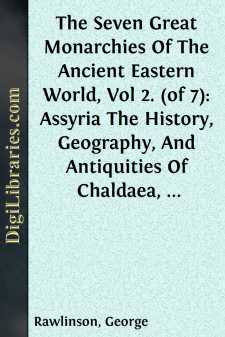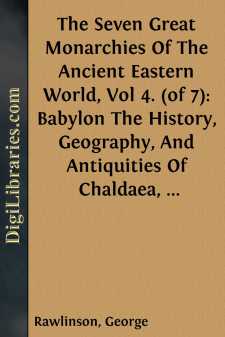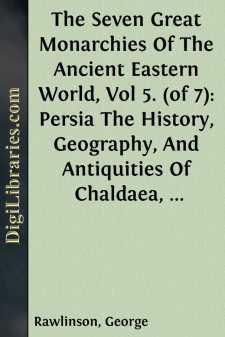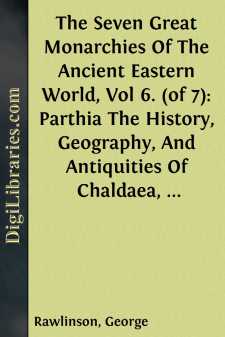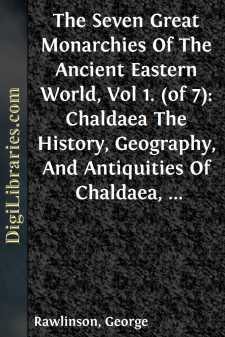Categories
- Antiques & Collectibles 13
- Architecture 36
- Art 48
- Bibles 22
- Biography & Autobiography 813
- Body, Mind & Spirit 142
- Business & Economics 28
- Children's Books 14
- Children's Fiction 11
- Computers 4
- Cooking 94
- Crafts & Hobbies 4
- Drama 346
- Education 46
- Family & Relationships 57
- Fiction 11829
- Games 19
- Gardening 17
- Health & Fitness 34
- History 1377
- House & Home 1
- Humor 147
- Juvenile Fiction 1873
- Juvenile Nonfiction 202
- Language Arts & Disciplines 88
- Law 16
- Literary Collections 686
- Literary Criticism 179
- Mathematics 13
- Medical 41
- Music 40
- Nature 179
- Non-Classifiable 1768
- Performing Arts 7
- Periodicals 1453
- Philosophy 64
- Photography 2
- Poetry 896
- Political Science 203
- Psychology 42
- Reference 154
- Religion 513
- Science 126
- Self-Help 84
- Social Science 81
- Sports & Recreation 34
- Study Aids 3
- Technology & Engineering 59
- Transportation 23
- Travel 463
- True Crime 29
The Seven Great Monarchies Of The Ancient Eastern World, Vol 2. (of 7): Assyria The History, Geography, And Antiquities Of Chaldaea, Assyria, Babylon, Media, Persia, Parthia, And Sassanian or New Persian Empire; With Maps and Illustrations.
by: George Rawlinson
Description:
Excerpt
CHAPTER I.
DESCRIPTION OF THE COUNTRY."Greek phrase[—]"—HEROD. i. 192.
The site of the second—or great Assyrian-monarchy was the upper portion of the Mesopotamian valley. The cities which successively formed its capitals lay, all of them, upon the middle Tigris; and the heart of the country was a district on either side that river, enclosed within the thirty-fifth and thirty-seventh parallels. By degrees these limits were enlarged; and the term Assyria came to be used, in a loose and vague way, of a vast and ill-defined tract extending on all sides from this central region. Herodotus considered the whole of Babylonia to be a mere district of Assyria. Pliny reckoned to it all Mesopotamia. Strabo gave it, besides these regions, a great portion of Mount Zagros (the modern Kurdistan), and all Syria as far as Cilicia, Judaea, and Phoenicia.
If, leaving the conventional, which is thus vague and unsatisfactory, we seek to find certain natural limits which we may regard as the proper boundaries of the country, in two directions we seem to perceive an almost unmistakable line of demarcation. On the east the high mountain-chain of Zagros. penetrable only in one or two places, forms a barrier of the most marked character, and is beyond a doubt the natural limit for which we are looking. On the south a less striking, but not less clearly defined, line—formed by the abutment of the upper and slightly elevated plain on the alluvium of the lower valley—separates Assyria from Babylonia, which is best regarded as a distinct country. In the two remaining directions, there is more doubt as to the most proper limit. Northwards,we may either view Mount Masius as the natural boundary, or the course of the Tigris from Diarbekr to Til, or even perhaps the Armenian mountain-chain north of this portion of the Tigris, from whence that river receives its early tributaries. Westward, we might confine Assyria to the country watered by the affluents of the Tigris, or extend it so as to in elude the Khabour and its tributaries, or finally venture to carry it across the whole of Mesopotamia, and make it be bounded by the Euphrates. On the whole it is thought that in both the doubted cases the wider limits are historically the truer ones. Assyrian remains cover the entire country between the Tigris and the Khabour, and are frequent on both banks of the latter stream, giving unmistakable indications of a long occupation of that region by the great Mesopotamian people. The inscriptions show that even a wider tract was in process of time absorbed by the conquerors; and if we are to draw a line between the country actually taken into Assyria, and that which was merely conquered and held in subjection, we can select no better boundary than the Euphrates westward, and northward the snowy mountain-chain known to the ancients as Mons Niphates.
If Assyria be allowed the extent which is here assigned to her, she will be a country, not only very much larger than Chaldaea or Babylonia, but positively of considerable dimensions....


